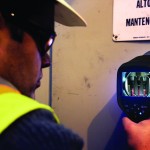Over the last 10 years advances in Thermal Imaging technology have resulted in a much wider application of the technology, and a greater use generally across industry. This has led to a greater demand for additional inspection, and with this, more users are including electrical panels and switch gear in their regular checks. This presents two very specific challenges, the first being that for an effective Infrared inspection, the equipment should be inspected live, and secondly, access to the internal components of such equipment is of necessity limited to certified personnel, and protected by safety trips and interlocks.
An effective way to enable an inspection is the introduction of “Infrared Windows” in the panel or equipment to allow a live inspection without having to open the cabinet. Some systems are supplied as a covered mesh or grille, where the operator can temporarily open the cover and use the camera to inspect. While this may satisfy in the most basic sense the safety requirement to prevent access, it certainly does not remove the risk of personally injury (or worse) caused by possible arc flash. A much better solution is to use a physical material in the window that is transparent to IR and provides a continuous barrier to the cabinet. If produced by a reputable manufacturer, they will have a been tested for arc flash resilience, vibration resistance and have various insurance ratings such as UL, IEEE etc. Infrared windows will not prevent, nor survive an arc flash incident, however their use will reduce the risk of exposing an inspector to an incident.
Manufacturers of infrared windows use a variety of materials depending on their technical performance and while they all do pretty much the same job, there are important differences in the material properties that need to be considered. In the main infrared windows materials are either a crystalline material such as Calcium Flouride (CaF2), or various proprietary polymer window materials..
It is important to note that while infrared windows may be transparent in the IR spectrum, they will not be transmitting 100% of the IR energy, and the inspector needs to adjust the camera setting to compensate for the window transmission – Failure to do this will result in an error in the temperatures calculated in the camera. All suppliers will be able to provide the transmission factor, and some provide that information on each window. As the manufacturers use a variety of materials, in an ideal world it is better for a site to standardise and reduce the risk of error, however, this may not be possible for equipment that is delivered with pre-installed Infrared Windows and care should be taken to ensure that the transmission factor is labelled on the window closure. Note that the Crystalline materials have a propensity to change their properties over time – in particular their transmission and their popularity is decreasing.
How much can I see with an IR Window?
– as with many technical questions this depends on the installation, the window diameter, and also on the camera being used (although the lens is probably more important here). Naturally you will not be able to scan a whole cabinet from a single window, but as many of the components are not significant, windows are normally installed so that they can cover the main component or components of interest. This might be an important contactor, or may be the 3-phase fuse installation for example. A wider angle lens, such as a 45° or 90° will allow more components to be inspected. Some window materials are also transparent in the visible spectrum, allowing the inspector to take a visible image as well – although the benefit of this is not always obvious as the interior of most cabinets are not illuminated and the lamps and visible light cameras on the majority of Thermal cameras are not designed to give a good image under these conditions.
 How do I install an IR Window?
How do I install an IR Window?
In an ideal world the windows will be fitted by the OEM at the manufacturing stage, and this is being requested as a part of the equipment specification stage, however with existing installations this is not the case. It is not a part of this article to discuss whether this affects the safety rating of the cabinet although this must be a consideration. The majority of IR Window suppliers will provide kits to allow the windows to be installed in a cabinet – some without having to open the panel. The window is then fitted and secured according to their particular instructions. Installers should ensure that they have checked that the installed equipment of interest has actually been installed in the locations indicated on the drawings, and that wherever possible any cables are not restricting the field of view.
In summary, infrared windows can improve the frequency of equipment inspection of critical equipment, resulting in earlier knowledge of impending problems and increased availability of plant and machinery. Inspections can be carried out without opening cabinets, reducing risk to the inspector and may reduce the requirement for a Thermographer to be accompanied by a certified electrician. Infrared windows can be retrofitted to existing cabinets relatively simply.
For more information about IR Windows please contact Crimson Industrial Vision at www.crimsoniv.co.uk or via email at marketing@crimsoniv.co.uk
